现在完成时态的用法
- 格式:doc
- 大小:64.00 KB
- 文档页数:5

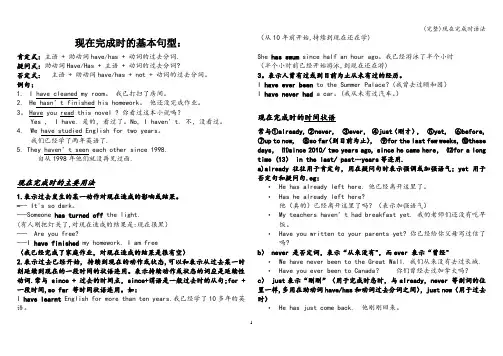
(完整)现在完成时语法现在完成时的基本句型:肯定式:主语 + 助动词have/has + 动词的过去分词.疑问式:助动词Have/Has + 主语 + 动词的过去分词?否定式:主语 + 助动词have/has + not + 动词的过去分词。
例句:1. I have cleaned my room。
我已打扫了房间。
2. He hasn’t finished his homework。
他还没完成作业。
3。
Have you read this novel ? 你看过这本小说吗?Yes , I have. 是的,看过了。
No, I haven’t. 不,没看过。
4. We have studied English for two years。
我们已经学了两年英语了.5. They haven’t seen each other since 1998.自从1998年他们就没再见过面.现在完成时的主要用法1.表示过去发生的某一动作对现在造成的影响或结果。
-— It's so dark。
-—Someone has turned off the light.(有人刚把灯关了,对现在造成的结果是:现在很黑)-— Are you free?-—I have finished my homework. I am free(我已经完成了家庭作业,对现在造成的结果是很有空)2.表示过去已经开始, 持续到现在的动作或状态,可以和表示从过去某一时刻延续到现在的一段时间的状语连用。
表示持续动作或状态的词应是延续性动词.常与since + 过去的时间点,since+谓语是一般过去时的从句;for + 一段时间,so far 等时间状语连用。
如:I have learnt English for more than ten years.我已经学了10多年的英语。
(从10年前开始,持续到现在还在学)She has swum since half an hour ago。
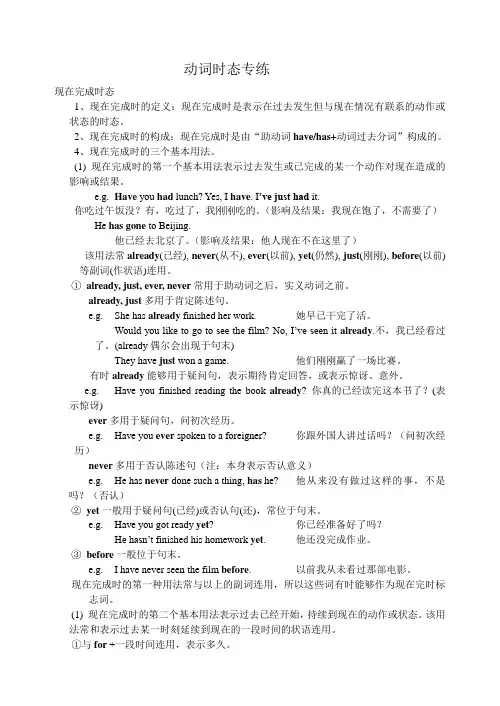
动词时态专练现在完成时态1、现在完成时的定义:现在完成时是表示在过去发生但与现在情况有联系的动作或状态的时态。
2、现在完成时的构成:现在完成时是由“助动词have/has+动词过去分词”构成的。
4、现在完成时的三个基本用法。
(1) 现在完成时的第一个基本用法表示过去发生或已完成的某一个动作对现在造成的影响或结果。
e.g. H ave you had lunch? Yes, I have. I’ve just had it.你吃过午饭没?有,吃过了,我刚刚吃的。
(影响及结果:我现在饱了,不需要了)He has gone to Beijing.他已经去北京了。
(影响及结果:他人现在不在这里了)该用法常already(已经), never(从不), ever(以前), yet(仍然), just(刚刚), before(以前)等副词(作状语)连用。
①already, just, ever, never常用于助动词之后,实义动词之前。
already, just多用于肯定陈述句。
e.g. She has already finished her work. 她早已干完了活。
Would you like to go to see the film? No, I’ve seen it already.不,我已经看过了。
(already偶尔会出现于句末)They have just won a game. 他们刚刚赢了一场比赛。
有时already能够用于疑问句,表示期待肯定回答,或表示惊讶、意外。
e.g. Have you finished reading the book already? 你真的已经读完这本书了?(表示惊讶)ever多用于疑问句,问初次经历。
e.g. Have you ever spoken to a foreigner? 你跟外国人讲过话吗?(问初次经历)never多用于否认陈述句(注:本身表示否认意义)e.g. He has never done such a thing, has he? 他从来没有做过这样的事,不是吗?(否认)②yet一般用于疑问句(已经)或否认句(还),常位于句末。
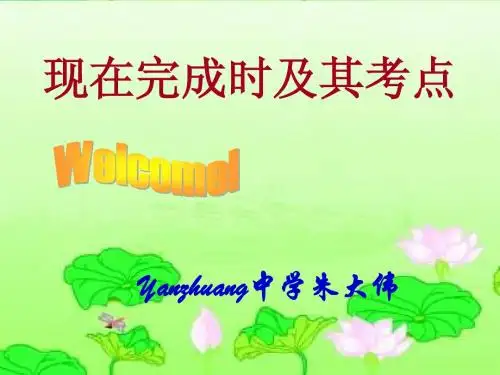
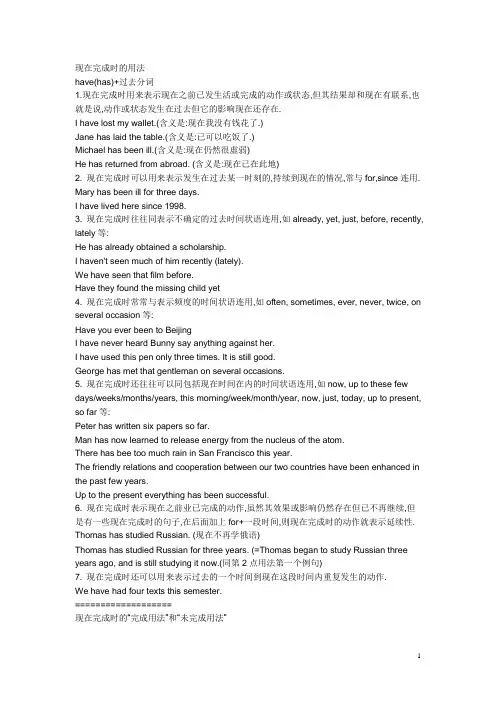
现在完成时的用法have(has)+过去分词1.现在完成时用来表示现在之前已发生活或完成的动作或状态,但其结果却和现在有联系,也就是说,动作或状态发生在过去但它的影响现在还存在.I have lost my wallet.(含义是:现在我没有钱花了.)Jane has laid the table.(含义是:已可以吃饭了.)Michael has been ill.(含义是:现在仍然很虚弱)He has returned from abroad. (含义是:现在已在此地)2. 现在完成时可以用来表示发生在过去某一时刻的,持续到现在的情况,常与for,since连用. Mary has been ill for three days.I have lived here since 1998.3. 现在完成时往往同表示不确定的过去时间状语连用,如already, yet, just, before, recently, lately等:He has already obtained a scholarship.I haven't seen much of him recently (lately).We have seen that film before.Have they found the missing child yet4. 现在完成时常常与表示频度的时间状语连用,如often, sometimes, ever, never, twice, on several occasion等:Have you ever been to BeijingI have never heard Bunny say anything against her.I have used this pen only three times. It is still good.George has met that gentleman on several occasions.5. 现在完成时还往往可以同包括现在时间在内的时间状语连用,如now, up to these few days/weeks/months/years, this morning/week/month/year, now, just, today, up to present, so far等:Peter has written six papers so far.Man has now learned to release energy from the nucleus of the atom.There has bee too much rain in San Francisco this year.The friendly relations and cooperation between our two countries have been enhanced in the past few years.Up to the present everything has been successful.6. 现在完成时表示现在之前业已完成的动作,虽然其效果或影响仍然存在但已不再继续,但是有一些现在完成时的句子,在后面加上for+一段时间,则现在完成时的动作就表示延续性. Thomas has studied Russian. (现在不再学俄语)Thomas has studied Russian for three years. (=Thomas began to study Russian three years ago, and is still studying it now.(同第2点用法第一个例句)7. 现在完成时还可以用来表示过去的一个时间到现在这段时间内重复发生的动作.We have had four texts this semester.===================现在完成时的“完成用法”和“未完成用法”1.现在完成时的"完成用法"现在完成时的"完成用法"指的是动作发生在过去某一时刻并已结束,但该动作对现在产生了影响,与现在情况具有因果关系。
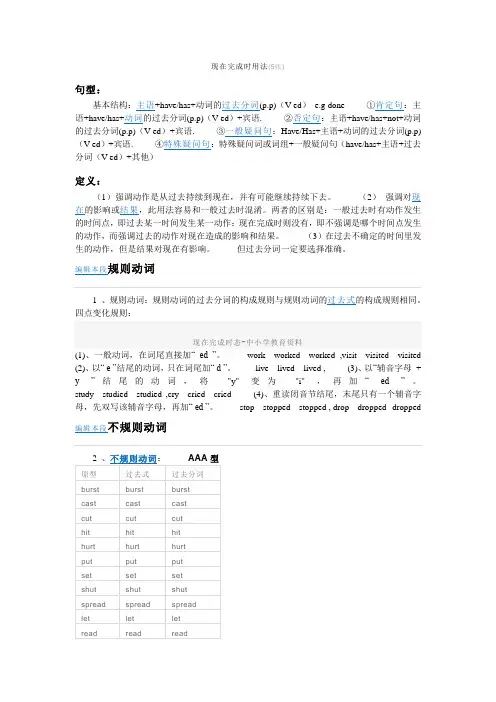
现在完成时用法(5张)句型:(V-ed)e.g done语(p.p)(V-ed)+宾语. +have/has+not+动词的过去分词(p.p)(V-ed)+宾语. Have/Has+主语+动词的过去分词(p.p)(V-ed)+宾语. +一般疑问句(have/has+主语+过去分词(V-ed)+其他)定义:(1)强调动作是从过去持续到现在,并有可能继续持续下去。
(2)的时间点,即过去某一时间发生某一动作;现在完成时则没有,即不强调是哪个时间点发生的动作,而强调过去的动作对现在造成的影响和结果。
(3)在过去不确定的时间里发生的动作,但是结果对现在有影响。
但过去分词一定要选择准确。
1四点变化规则:现在完成时态-中小学教育资料(1)、一般动词,在词尾直接加“ ed ”。
work---worked---worked ,visit---visited---visited(2)、以“ e ”结尾的动词,只在词尾加“ d ”。
live---lived---lived , (3)、以“辅音字母+ y ”结尾的动词,将"y" 变为"i" ,再加“ ed ”。
study---studied---studied ,cry---cried---cried (4)、重读闭音节结尾,末尾只有一个辅音字母,先双写该辅音字母,再加“ ed ”。
stop---stopped---stopped , drop---dropped--dropped(read原形发音为/ri:d/,过去式和过去分词发音为/red/) ABB型①for+时段为…时间②since+过去一个时间点(译为:自从……以来)③since+时段+ago ④since+从句(过去时)●⑤It is+时段+since+从句(过去时)(buy,die,join,lose……)不能直接与for since 连用。
要改变动词come/arrive/reach/get to-----be in go out----be out finish----be over open----be open die----be dead Buy---have Fall ill---be ill Come back---be back Put on ---be on/wear Worry---be worried Catch a cold---have a cold ……………… ★1.have代替buy My brother has had(不能用has bought) this bike for almost four years. ★2、用keep或have 代替borrow I have kept(不能用have borrowed) the book for quite a few days. ★3、用be替代become How long has your sister been a teacher? ★4、用have a cold代替catch a cold Tom has had a cold since the day before yesterday. ★5、用wear代替puton b)用1、be+married代marry 2、be+ill代fall (get) ill 3、be+dead代die 4、be+asleep代fall (get) asleep 5、be+awake代wake/wake up 6、be+gone 代lose,die,sell,leave 7、be+open代open 8、be closed代close/shut 9、be+missing(gone,lost)代lose c)用“be+副词”代终止性动词1“be+on”代start,begin 2“be+up”代get up 3“be+back(to)”代return to,come back to,go back to 4“be here (there)”代come(arrive,reach,get) here或go (arrive,reach,get) there等等d)用“be+介词短语”代终止性动词 1.“be in/at +地点”代替go to /come to 2.用be in the army 代替jointhe army 3.“be in/at +地点”代替move to常用瞬间动词变延续性动词表:1. have arrived at/in sw. got to/reached sw. come/gone/moved to sw. have been in sw./at…相应的介词2. have come/gone back/returned have been back 3. have come/gone out have been out4. have become have been5. have closed / opened have been closed/opened6. have got up have been up;7. have died have been dead;8. have left sw. have been away from sw.9. have fallen asleep/got to sleep have been asleep;10. have finished/ended/completed have been over;11. have married have been married;12. have started/begun to do sth. have done sth. ;13. have begun have been on14. have borrowed/bought have kept/had 15. have lost haven’t had16. have put on have worn 17. have caught /get a cold have had a cold;18. have got to know have known19. have/has gone to have been in20. have joined/have taken part in the league/the Party/the armyhave been a member of/ have been in/have been the Party’s member/the league member/the soldier…1.现在完成时不能单独与准确时间连用,(如表示过去的时间状语)如yesterday(morning、afternoon),last(morning、afternoon)等,除非与for,since连用.2.现在完成时往往同表示不确定的过去时间状语连用,如already(肯定), yet(否定,疑问), just, before, recently,still, lately,never等: He has already obtained a scholarship. I haven't seen much of him recently (lately). We have seen that film before. Have they found the missing child yet ?3. 现在完成时常常与表示频度的时间状语连用,如often, sometimes, ever, never, twice, on several occasion等: Have you ever been to Beijing I have never heard Bunny say anything against her. I have used this pen only three times. It is still good. George has met that gentleman on several occasions.4. 现在完成时还往往可以同包括现在时间在内的时间状语连用,如now, up to these few days/weeks/months/years, this morning/week/month/year, just, today, up to present, so far等: Peter has written six papers so far. Man has now learned to release energy from the nucleus of the atom. There has been too much rain in San Francisco this year. The friendly relations and cooperation between our two countries have been enhanced in the past few years. Up to the present everything has been successful.5. 现在完成时还可以用来表示过去的一个时间到现在这段时间内重复发生的动作.We have had four texts this semester. 6.现在完成时的"完成用法"现在完成时的"完成用法"指的是动作发生在过去某一时刻并已结束,但该动作对现在产生了影响,与现在情况具有因果关系。
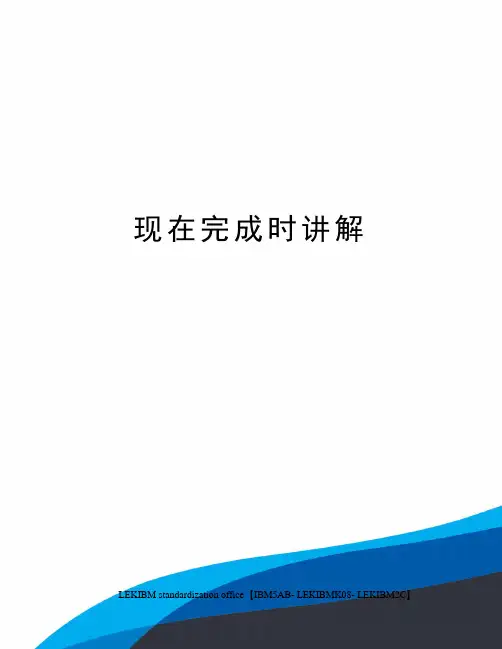
现在完成时讲解LEKIBM standardization office【IBM5AB- LEKIBMK08- LEKIBM2C】现在完成时讲解一.基本结构:助动词have/has+过去分词(done)二.句型:否定句:主语+have/has+not+过去分词+其他. 一般疑问句:Have/Has+主语+过去分词+其他. 简略答语: Yes, 主语 + have/has.(肯定) No, 主语 + haven't/hasn't.(否定)三.用法(1)现在完成时表示过去发生或已经完成的动作对现在造成的影响或结果I have spent all of my money (so far).(含义是:现在我没有钱花了.)Guo zijun has (just/already) come. (含义:郭子君现在在这儿)My father has gone to work.(含义是:我爸爸现在不在这儿)(2)现在完成时可以用来表示发生在过去某一时刻的,持续到现在的动作(用行为动词表示)或状态(be动词表示)常与for(+时间段),since(+时间点或过去时的句子)连用.①for+时段②since+过去一个时间点(译为:自从……以来)③since+时段+ago④since+从句(过去时)⑤It is+时段+since+从句(过去时)Mary has been ill for three days.I have lived here since 1998.四.has gone (to),has been (to), has been (in) 的区别Have/Has gone(to) :去了(现在不在说话现场)Where is your father?He has gone to Shanghai.Have/Has been (to) :去过(已不在去过的地方)My father has been to Shanghai.Have/has been in:呆了多久(还在所呆的地方)My father has been in Shanghai for two months. /since two months ago.五.现在完成时的标志1.现在完成时的含义之一是过去完成的动作对现在仍有影响,用以下四大标志词可以表达这种含义:* 以already, just和yet为标志He has already got her help.他已得到她的帮助。
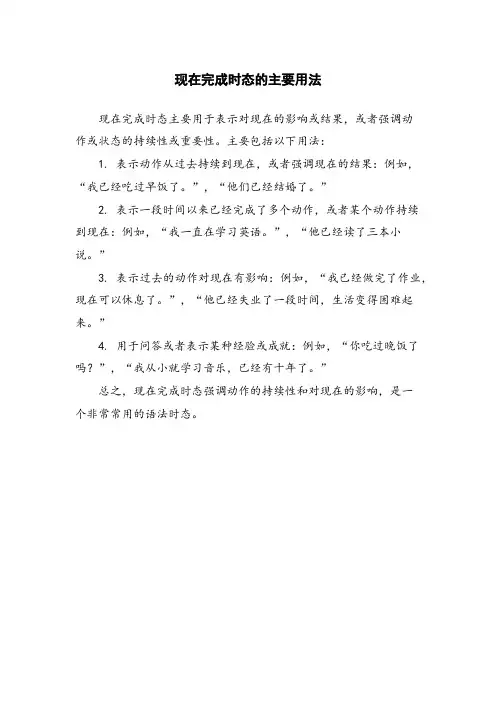
现在完成时态的主要用法
现在完成时态主要用于表示对现在的影响或结果,或者强调动
作或状态的持续性或重要性。
主要包括以下用法:
1. 表示动作从过去持续到现在,或者强调现在的结果:例如,“我已经吃过早饭了。
”,“他们已经结婚了。
”
2. 表示一段时间以来已经完成了多个动作,或者某个动作持续
到现在:例如,“我一直在学习英语。
”,“他已经读了三本小说。
”
3. 表示过去的动作对现在有影响:例如,“我已经做完了作业,现在可以休息了。
”,“他已经失业了一段时间,生活变得困难起来。
”
4. 用于问答或者表示某种经验或成就:例如,“你吃过晚饭了吗?”,“我从小就学习音乐,已经有十年了。
”
总之,现在完成时态强调动作的持续性和对现在的影响,是一
个非常常用的语法时态。
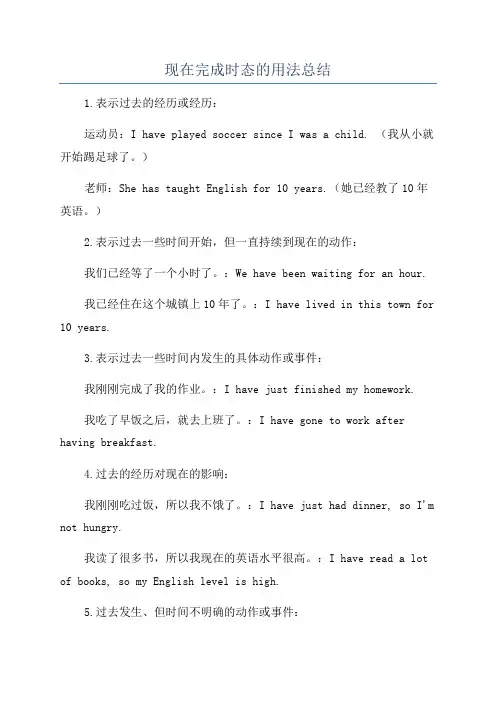
现在完成时态的用法总结
1.表示过去的经历或经历:
运动员:I have played soccer since I was a child. (我从小就开始踢足球了。
)
老师:She has taught English for 10 years.(她已经教了10年英语。
)
2.表示过去一些时间开始,但一直持续到现在的动作:
我们已经等了一个小时了。
:We have been waiting for an hour.
我已经住在这个城镇上10年了。
:I have lived in this town for 10 years.
3.表示过去一些时间内发生的具体动作或事件:
我刚刚完成了我的作业。
:I have just finished my homework.
我吃了早饭之后,就去上班了。
:I have gone to work after having breakfast.
4.过去的经历对现在的影响:
我刚刚吃过饭,所以我不饿了。
:I have just had dinner, so I'm not hungry.
我读了很多书,所以我现在的英语水平很高。
:I have read a lot of books, so my English level is high.
5.过去发生、但时间不明确的动作或事件:
我看过这部电影。
:I have seen this movie.你去过巴黎吗?:Have you been to Paris?。
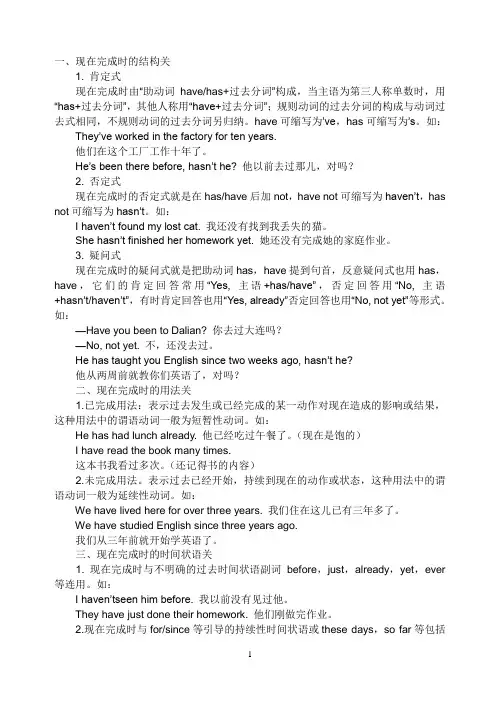
一、现在完成时的结构关1. 肯定式现在完成时由“助动词have/has+过去分词”构成,当主语为第三人称单数时,用“has+过去分词”,其他人称用“have+过去分词”;规则动词的过去分词的构成与动词过去式相同,不规则动词的过去分词另归纳。
have可缩写为’ve,has可缩写为’s。
如:They’ve worked in the factory for ten years.他们在这个工厂工作十年了。
He’s been there before, hasn’t he?他以前去过那儿,对吗?2. 否定式现在完成时的否定式就是在has/have后加not,have not可缩写为haven’t,has not可缩写为hasn’t。
如:I haven’t found my lost cat. 我还没有找到我丢失的猫。
She hasn’t finished her homework yet. 她还没有完成她的家庭作业。
3. 疑问式现在完成时的疑问式就是把助动词has,have提到句首,反意疑问式也用has,have,它们的肯定回答常用“Yes, 主语+has/have”,否定回答用“No, 主语+hasn’t/haven’t”,有时肯定回答也用“Yes, already”否定回答也用“No, not yet”等形式。
如:—Have you been to Dalian? 你去过大连吗?—No, not yet. 不,还没去过。
He has taught you English since two weeks ago, hasn’t he?他从两周前就教你们英语了,对吗?二、现在完成时的用法关1.已完成用法:表示过去发生或已经完成的某一动作对现在造成的影响或结果,这种用法中的谓语动词一般为短暂性动词。
如:He has had lunch already. 他已经吃过午餐了。
(现在是饱的)I have read the book many times.这本书我看过多次。
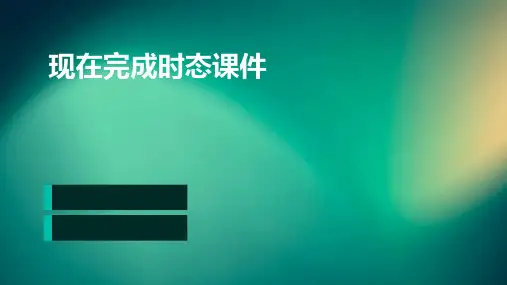
现在完成时的四种用法现在完成时是英语中一个很重要的时态,也是很容易弄错的一个时态。
归纳起来,现在完成时共有四种主要用法,现分别解说如下:一、现在完成时表示影响该用法的现在完成时表示一个过去发生的动作在过去已经完成,并且这个过去发生并完成的动作对现在有影响或结果,同时说话者强调的或感兴趣的就是这个影响或结果,如汉语说“他已离开这个城市了”,其中的“离开”肯定发生了,它对现在的影响或结果就是“他现在已不在这个城市了”;又如汉语说“有人把窗户打破了”,显然“打破窗户”这一动作发生在过去,并且在过去已经完成了,但说话人强调的重点是打破窗户对现在的影响——窗户现在仍是破的。
如:He has left the city. 他已离开这个城市。
(结果:他不在这个城市。
)Someone has broken the window. 有人把窗户打破了。
(结果:窗户仍破着。
)I have lost my pen. 我把钢笔丢了。
(结果:我现在无钢笔用。
)He has finished his work. 他把工作做完了。
(结果:他现在可以做其他的事了。
)二、现在完成时表示持续该用法的现在完成时表示一个过去发生的动作或开始的状语在过去并未完成或结束,而是一直持续到现在,并且有可能继续下去(也可能到此结束),如汉语说“他在我们学校教书已有30年了”,显然“他在我们学校教书”是从30年前开始,并且一直教到现在,已经持续了30年;又如汉语说“自上个星期以来他一直很忙”,显然“忙”是从上个星期开始的,并且这一“忙”就一直忙到现在。
如:He has taught in our school for 30 years. 他在我们学校教书已有30年了。
He has been busy since last week. 自上个星期以来他一直很忙。
英语微信群是目前学习英语最有效的方法,群里都是说英语,没有半个中文,而且规则非常严格,是一个超级不错的英语学习环境,群里有好多英语超好的超牛逼的人,还有鬼佬和外国美眉。
现在完成时用来表示之前已发生或完成的动作或状态,其结果的确和现在有联系。
动作或状态发生在过去但它的影响现在还存在;也可表示持续到现在的动作或状态。
现在完成时用法1:表示过去发生的动作或事情,对现在造成的影响。
2:表示从过去开始发生的动作持续到现在,有可能马上结束,但也有可能继续下去。
3:现在完成时的动词必须具有可持续性,至少是能重复一次以上的动作。
句型构成基本结构:主语+have/has+动词的过去分词.......①肯定句:主语+have/has+动词的过去分词+宾语+其他.②否定句:主语+have not/has not+动词的过去分词+宾语+其他.③一般疑问句:Have/Has+主语+动词的过去分词+宾语+其他?用法要点1.现在完成时不能单独与准确时间状语连用,(如表示过去的时间状语)如yesterday(morning、afternoon),last(morning、afternoon)等,除非与for,since 连用.2.现在完成时往往同表示不确定的过去时间状语连用如already(肯定,句中),yet(否定,疑问,句中),just,before,recently,still,lately,never 等3. 现在完成时态经常与表示频度的时间状语连用,如often,sometimes,ever,never,twice,on several occasion等:4. 现在完成时还往往可以同包括现在时间在内的时间状语连用如now,up to these few days/weeks/months/years,this morning/week/month/year,just,today,up to present,so far等:5.现在完成时还可以用来表示过去的一个时间到现在这段时间内重复发生的动作.6.现在完成时的"完成用法"指的是动作发生在过去某一时刻并已结束。
现在完成时态的概念,基本用法以及过去分词的变法一.基本结构:助动词have/has+过去分词二.句型:否定句:主语+have/has+not+过去分词+其他.一般疑问句:Have/Has+主语+过去分词+其他.简略答语: Yes, 主语+ have/has.(肯定)No, 主语+ haven't/hasn't.(否定)三.用法(1)现在完成时表示过去发生或已经完成的动作对现在造成的影响或结果I have spent all of my money.(含义是:现在我没有钱花了.)Guo zijun has (just/already) come. (含义:郭子君现在在这儿)My father has gone to work. 我爸爸已经去上班了(含义是:我爸爸现在不在这儿)(2)过去已经开始的动作一直持续到现在, 甚至有可能继续持续下去,可以和表示延续的时间状语连用。
表示持续动作或状态的动词多是延续性动词。
①for + 时段②since+过去一个时间点(译为:自从……以来)③since+时段+ago④since+从句(过去时)●⑤It is+时段+since+从句(过去时)Mary has been ill for three days.玛丽已经病了三天了。
I have lived here since 1998.自从1998年我就已经居住在这了I have been a student since two years ago.两年前我就已经成为一名学生了She has taught us since I came to this school.自从我来到这个学校她就教我了It is two years since he became a student.四.has gone (to),has been (to), has been (in) 的区别Have/Has gone(to) :去了(现在不在说话现场)Where is your father?He has gone to Shanghai.他已经去上海了。
例: He has bought the book for 3 years 錯)因buy 这个一次性动词不能和一段时间 for 3 years 连用,改正的办法有五种:现在完成时态1. 用法:①表示过去发生的动作对现在造成的影响和结果,强调结果 .常用的 时间状语有 many times just, yet ,ever ,never, just, already, so far, by now 等。
②表示动作或者状态在过去已经开始,持续到现在,也许还将持续下去。
用于延续性动词,常常与so far for 或者since 短语连用。
since +时间点/从句, for + 时间段,女口 for two months 等。
2. 现在完成时的构成 have has+过去分词3. 现在完成时的四个基本句型肯定句 He has finished the work. 一般疑问句 Has he finished the work? 否定句 He has not finished the work 两回答 Yes ,he has. No, he hasn t.特殊疑问句 What has he done?4. 在下列情形下用现在完成时1九词语①already 已经 肯定句中或句尾 my pen already.② yet 已经 否定句和疑问句句尾 例:I have not finished the work yet.Have you bought a computer yet?例: Have you ever seen pandas? 例: I have never been to Beijing.例: I have just done my work. 例: I have never been there before. 例:So far he has learnt 200 words. 例: How long have you lived here?⑨how many times 多少次 例: How many times has he been to Beijing?2两词组 since 3 years ago since 1990 since he came heresince 过去时态句子 He has been in China since he came here.4如果句子里面没有时间状语, 汉语意思能够加“已经”,往往用现在完成时态。
2012,2月8-9日时限:90分钟(共两页)家长签字:现在完成时:H a v e/h a s+过去分词用法I.(曾经)做过某事I_________(s e e)t h i s f i l m.他看过这部电影。
2.T h e y_____(r e a d)t h i s b o o k.他们读过这本书。
3.____y o u____(c l i m b)t h e m o u n t a i n?你爬过山吗?I I.已经完成某事了1.我写完作业了I________(w r i t e)m y h o m e w o r k.2.我读完这本书了I_________(r e a d)t h i s b o o k.3.我吃了饭了I_______(h a v e)d i n n e r.I I I.动作已经发生了,但强调的是现在1H e____(f i n d)t h e s e c r e t.(暗含的意思:他现在已经知道秘密了)2.T h e y____(f i n d)t h e i r c h i l d.(暗含的意思:他们找到了孩子,他们现在很高兴)3.I____(l o s e)m y p e n.(暗含的意思:我找到钢笔了,我现在不麻烦了)I V.过去的动作或者状态一直持续到现在,与f o r,s i n c e连用用f o r和s i n c e填空1.I h a v e s t u d i e d E n g l i s h____t h r e e y e a r s.2.S h e h a s l i v e d t h e r e___20003.H e h a s b e e n h e r e____t h r e e m o n t h s a g o.4.W e h a v e t a u g h t E n g l i s h____s e v e n t e e n y e a r s.5.H e h a s k n o w n u s___I c a m e t o t h i s s c h o o l.V.延续性动词和短暂性动词延续性动词可以和f o r,s i n c e引导的一段时间连用,而短暂性性动词则不能。
句型转换1.T o m c a m e h e r e t w o h o u r s a g oT o m______________f o r t w o h o u r s2.L i n g l i n g l e f t B e i j i n g t w o y e a r s a g o.1L i n g l i n g_______________f r o m B e i j i n g f o r t w o y e a r s。
3.I b o u g h t t h i s b o o k s i n c e l a s t m o n t h.I__________t h i s b o o k s i n c e t h r e e d a y s a g o.4.L i l y b o r r o w e d a b i k e s i n c e l a s t m o n t h.L i l y______a b i k e s i n c e l a s t m o n t h.5.G r a n d m a L i d i e d i n1990.G r a n d m a L i___________s i n c e1990.6.U n c l e W a n g j o i n e d t h e P a r t y i n2000.U n c l e W a n g_______a p a r t y___s i n c e2000.V I.E x e r c i s e s:1.-W h e n__y o u___t h i s b o o k?-I___I t f o r t w o w e e k s.A.h a v e;b o u g h t;h v e h a d.B.d i d;b u y;h a v e h a dC.h a v e;b o u g h t;b o u g h tD.d i d;b u y;h a v e b o u g h t2.T h e t w i n s___t o t h a t f a r m s e v e r a l t i m e s.A.h a v e b e e nB.h a v e g o n eC.h a v e c o m eD.a r e3.–I s t h a t C h r i s s p e a k i n g?-S o r r y,h e i n s n’t i n.H e___t o D a l i n a n o n b u s i n e s s.A.h a s b e e nB.h a s g o n eC.h a s w e n tD.h a v e w e n t4.-H a v e y o u e v e r b e e n a n y w h e r e f o r a t r i p?-A t r i p?I___a w a y f r o m m y h o m e t o w n s i n c e2000.A.w e n tB.h a v e g o n eC.h a v e n e v e r b e e nD.h a v e b e e n.5.–W o u l d y o u g o t o s e e t h e f l o w e r s h o w w i t h m e t h i s a f t e r n o o n?-I’m s o r r y,I’m b u s y a n d I___i t t w i c e.A.s e eB.s a wC.h a v e s e e nD.h a d s e e n6.H a v e y o u f i n i s h e d y o u r h o m e w o r k____?A.a l r e a d yB.y e tC.s t i l lD.n e v e r7.-___y o u___m y r u l e r?–Y e s,I___i t j u s t n o w.A.H a v e;s e e n;s a wB.D i d;s e e;s a wC.H a d,s e e n;s a wD.H a v e;s e e n;h a v e s e e n.8.-H o w l o n g___y o u___a c o l d?-E v e r s i n c e l a s t n i g h tA.h a v e;g o tB.h a v e;h a dC.h a v e;c a u g h t;D.d i d;h a v ea l s o g r o w i n g i n o t h e r86.S t u d e n t s s h o w t h a t t h e h e i g h t a n d w e i g h to f m o d e r n t e n-y e a r-o l d a r e87f r o m t h e h e i g h t a n d w e i g h t o f t h e i r p a r e n t s a t t e n.B r i t i s h t e n-y e a r-o l d a r e n o w o n a v e r a g e(平均)141c m t a l l(138---139c m i n1972).T h e88s t u d i e s s h o w a17%i n c r e a s e i n w e i g h t.T h e s t u d i e s d o n’t89r e a s o n s f o r t h i s,b u t w e c a n90t h a t t h e c h i l d r e n a r e91f o r t w o m a i n r e a s o n s:d i e t a n d e x e r c i s e.T h e s ed a y s c h i l d re n e a t92f o o d a l o t o f t i m e,a n d t h i s e x p l a i n s t h ei n c r e a s e i n93t o141c m,b u t t h e y a l s o e a t a l o t o f u n h e a l t h y f o o d,f o r e x a m l o w,s w e e t s,c h i p s,c a k e s a n d c h o c l o a t e s.A f t e r s c h o o l,m a n y o f t o d a y’s c h i l d r e n94d o w m a l l e v e n i n g.T h e y w a t c h T V,l i s t e n t o m u s i c,o r d o t h e i r h o m e w o r k,b u t t h e y o f t e n d o n’t95a n ye x e r c i s e.86.__________87._________88._________89._________90.__________91.__________92._________93.__________94.__________95._________答题日期2012,1,10答题时间:40分钟家长签字:_______2句型转换专练答题时间2012,2,10.答题时限40分钟家长签字:______ 1.T h e y a r e c l e a n i n g t h e i r c l a s s r o o m n o w.__________t h e y c l e a n i n g n o w?2.H e o f t e n h a s s u p p e r a t h o m e._________h e o f t e n_____s u p p e r?3.T h e y w i l l c o m e b a c k i n a m i n u t e.___________w i l l t h e y c o m e b a c k?4.I g o t u p a t s i x t h i s m o r n i n g.____________y o u_____u p t h i s m o r n i n g?5.H e f i n i s h e d t h e b o o k l a s t S u n d a y.__________h e____t h e b o o k?6.I d i d n’t g o t o s c h o o l b e c a u s e I h a d a b a d c o l d._________y o u g o t o s c h o o l?7.Y o u’d b e t t e r t a k e t h e N o.3b u s.______b u s_____I b e t t e r t a k e?8.H e’s f e e l i n g w e l l.__________h e f e e l i n g?9.T h e b o y o n t h e b i k e i s m y f r i e n d._________i s y o u r f r i e n d?10.H e c o m e s t o C h i n a o n c e a y e a r._______________h e_____t o C h i n a?11.T h e y w e r e d r a w i n g a h o r s e w h e n I c a m e i n.__________t h e y_____w h e n I c a m e i n?12.I t’l l b e w i n d y t o m o r r o w.____w i l l________________t o m o r r o w?13.T h e c a p i t a l o f A m e r i c a i s W a s h i n g t o n D.C.._________t h e c a p i t a l o f A m e r i c a?14.H u n d r e d s o f p e o p l e d i e d i n t h e w a r.__________p e o p l e____i n t h e w a r?15.I’v e w o r k e d h e r e f o r t e n y e a r s.___________h a v e y o u w o r k e d h e r e?16.T h e y w e n t t o t h e c o u n t r y s i d e w i t h m e.W i t h________t h e y____t o t h e c o u n t r y s i d e?17.S h e w a t c h e s T V e v e r y n i g h t._______________s h e_____T V?18.I t’s a b o u t t e n k i l o m e t e r s a w a y f r o m h e r e._______________i t f r o m h e r e?19.T h e b l o u s e c o s t t w o h u n d r e d y u a n._______________t h e b l o u s e_______?20.W e o f t e n g o o u t f o r a w a l k i n t h e e v e n i n g._________y o u o f t e n g o o u t f o r a w a l k?3主谓一致专项练习 2012,2,11 答题时间40分钟家长签字:_____1. Either Jane or Steven _____ watching TV now.A. wereB. isC. wasD. are2. Two days _______enough for me to finish the work, I need a third day.A. isn’tB. isC. are’tD. are3. —How many lessons do you usually have a day?—Six lessons a day. And each of them _____45 minutes.A. lastB. lastsC. haveD. are4. Neither Liping nor I _______a basketball player.A. amB. isC. beD. are5. There ______ many new words in lesson one,It is very easy.A. isB. aren’tC. isn’tD. are6. The number of the students in our school ____1200.A. isB. areC. hasD. have7. Maths _______ my favourite subject.A. beB. isC. amD. are8. The boy with the two dogs _____ when the earthquake rocked the city.A. were sleepingB. is sleepingC. was sleepingD. are asle9. Every one except Tom and John _____there when the meeting began.A. areB. isC. wereD. was10. That place is not interesting at all, ____of us wants to go ther e.A. NeitherB. BothC. AllD. Some11. Nobody but Jane _____ the secret.A. knowB. knowsC. have knowD. is12. —What’s on the plate? some eggs and cakes on it?—There _____some eggs and cakes on it.A. isB. areC. wasD. were13. This pair of glasses ______mine.A. areB. beC. isD. will be14. Both Lily and Lucy ______ to the party yesterday.A. invitedB. was invitedC. had invitedD. were invirted15. —Two months ______quite a long time.—Yes, I’m afraid that he will miss lots of his lessons.A. isB. areC. wasD. were16. In the city the old _______.A. take good care ofB. are taken good care ofC. is taken good care ofD. are been taken good care of17. His family _____all very kind and friendly, His family ______a happy one.A. are,isB. is,isC. are,areD. is,are18. The singer and the dancer _____come to Beijing.A. hasB. haveC. areD. is19. The children in this class each _____new school bag.A. haveB. hasC. has gotD. are having20. All but one _____ here just now.A. isB. wasC. has beenD. were21. “I'm going to visit the Lu Gou Bridge tomorrow.”“ .”A. I am soB. So am IC. So go ID. So I go22. You as well as he to blame(责备) for the accident(交通事故).A. areB. isC. haveD. has23. Neither my wife nor I myself able to teach my daughter to sing English songs.A. has been B. is C. are D. am45。